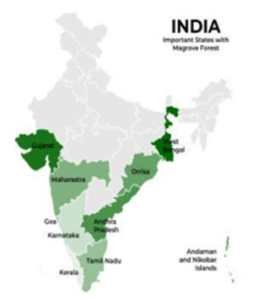Ethics Theory, TLP-UPSC Mains Answer Writing
Q. 2. Mangrove forests play a crucial role in enhancing climate resilience and safeguarding coastal ecosystems in India. Elaborate on their ecological importance in this context. What are the major anthropogenic threats contributing to their decline? (150 words, 10 marks)
Introduction
Mangrove forests are dense, salt-tolerant vegetations that occur along tropical and subtropical coastlines. India hosts the world’s fourth-largest mangrove cover, playing a pivotal role in climate adaptation and coastal protection.
Body
Ecological Importance of Mangroves in Climate Resilience
- Coastal Protection: Mangroves act as natural barriers against storm surges, cyclones, and coastal erosion by stabilising shorelines with their intricate root systems. Example: During the 1999 Odisha super cyclone, mangrove belts near Kendrapara significantly reduced destruction.
- Carbon Sequestration: Mangrove ecosystems are carbon-rich sinks, storing up to four times more carbon than tropical rainforests, thus mitigating greenhouse gas emissions. Example: Sundarbans store approximately 33 million tonnes of carbon.
- Biodiversity Support: They provide critical breeding and nursery grounds for marine species, supporting coastal fisheries and food security. Example: Bhitarkanika and Sundarbans mangroves support diverse species like the saltwater crocodile and Bengal tiger.
- Water Quality Regulation: Mangroves filter sediments, heavy metals, and pollutants, improving the quality of coastal waters and reducing eutrophication.
- Livelihood Support: Local communities depend on mangroves for firewood, honey, fish, and sustainable eco-tourism, making them essential for socio-economic resilience.
Major Anthropogenic Threats to Mangroves
- Urbanisation and Land Reclamation: Coastal cities expand into mangrove areas, leading to large-scale deforestation and habitat loss. Example: Mumbai and Navi Mumbai have lost substantial mangrove tracts to infrastructure projects.
- Aquaculture Expansion: Conversion of mangroves to shrimp farms alters salinity and depletes biodiversity. Example: Andhra Pradesh witnessed major mangrove decline due to brackish water aquaculture.
- Industrial Pollution and Oil Spills: Effluents from thermal plants, refineries, and ports affect mangrove soil and water quality, stunting growth.
- Unsustainable Tourism: Unregulated tourism damages root systems, increases litter, and alters hydrology in sensitive zones.
- Climate Change: Sea level rise and increasing salinity affect mangrove regeneration and zonation, particularly in low-lying delta regions.

Government Initiatives for Mangrove Conservation
- MISHTI (Mangrove Initiative for Shoreline Habitats & Tangible Incomes): Launched in Union Budget 2023–24, it aims at intensive afforestation of mangroves along India’s coastline through community participation.
- National Coastal Mission under NAPCC: Focuses on conserving coastal ecosystems, including mangroves, through vulnerability mapping and ecosystem-based adaptation.
- Integrated Coastal Zone Management Programme (ICZMP): Implements scientific mangrove management in states like Gujarat, Odisha, and West Bengal, promoting sustainable coastal development.
- CAMPA (Compensatory Afforestation Fund Management and Planning Authority): Utilises compensatory afforestation funds for mangrove regeneration and coastal afforestation projects.
Conclusion
Mangroves are frontline climate defenders and biodiversity hotspots. Their conservation requires integrated coastal zone management, community participation, and strict regulation of human activities to ensure long-term sustainability and ecological balance














